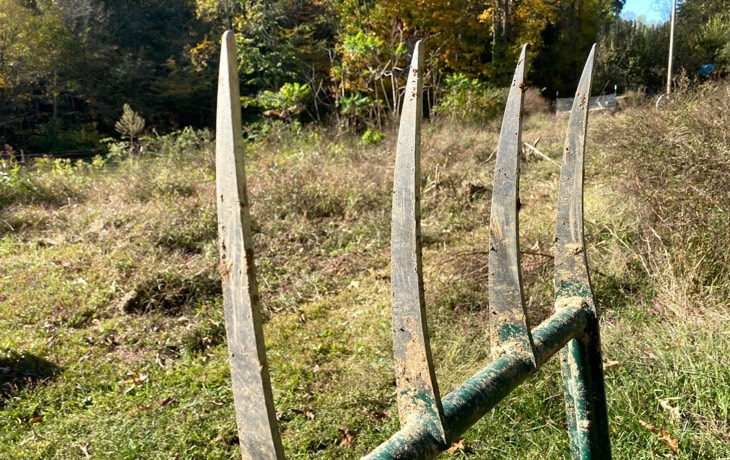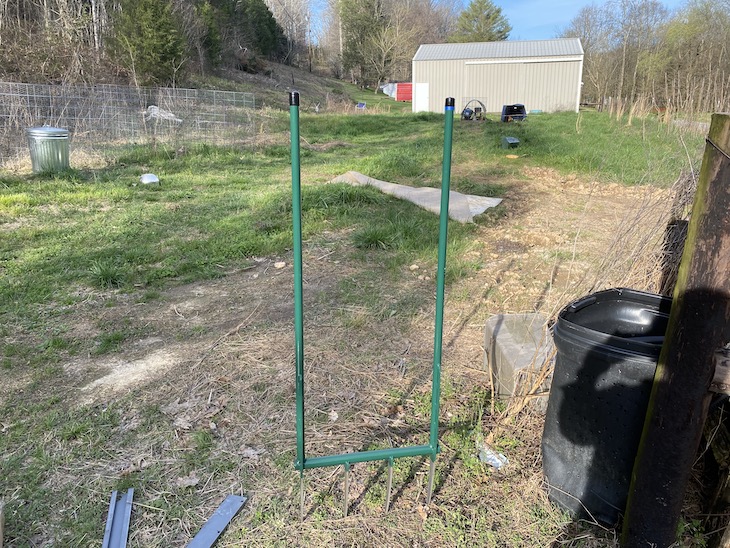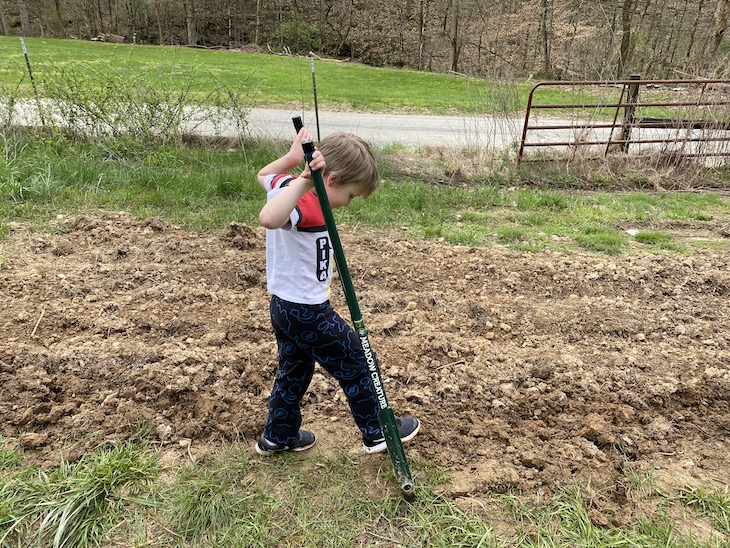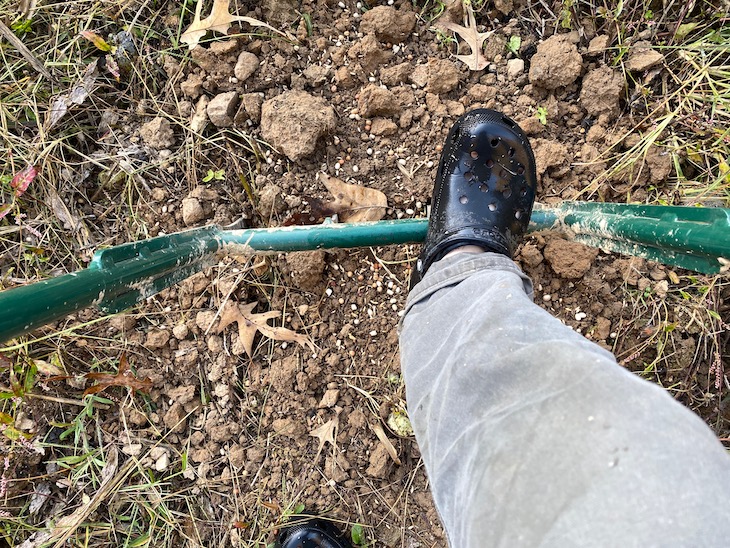Let’s say things have hit the fan and you dust off the seed vault you tucked away in the back of your pantry. Assuming your seeds haven’t gone bad, how would you dig a garden bed to plant them? Fire up a tractor or tiller? What if you couldn’t get gas?
The traditional way to build a garden bed by hand is double digging, as taught by John Jeavons and Steve Solomon. It’s a fine method, assuming you have a good shovel, a sturdy fork, and a back like a gorilla.
Here in Middle Tennessee, I have some of the hardest, rockiest soil known to man. You don’t just stick a shovel in the ground. Try it and you’ll be rewarded with a *clank* as the now-dulled shovel edge strikes one of the billions of rocks just underfoot. A standard digging fork doesn’t fare much better.
What about a no-till or lasagna garden, where you pile layers of organic matter over a garden bed and plant directly into it? It’s a fine method and its fans have an almost cult-like devotion to it, but it takes an absurd amount of materials to get started. The same amount of organic matter could make enough compost to feed my entire tilled garden, or it could be just enough for a single no-till bed.
So that means I’ve got to break soil, and I’ve found only one hand tool that can effectively break it: the Meadow Creature People’s Broadfork. Keep reading comrade, and I show you how to plant potato when the politburo provide no petrol.
It’s not even Halloween yet. Why are you bugging me about gardening?
I know, I know. It’s October and you want to hibernate on your couch watching football and Charlie Brown specials. Me too. Or maybe this year you’re on the other end of the spectrum: cleaning your guns and digging trenches around your house in anticipation of the boogaloo. Uh, also me too.
But now is the time to be thinking about your spring survival garden, for a few reasons:
- It’s cool outside, so the work is a lot easier than in the summer. If you haven’t gardened before, trust me, you don’t want to be doing the hard labor when it’s over 80F outside.
- Hand-digging beds is a slow, laborious task. The more lead time you give yourself, the easier you can take it. You don’t want to be hurriedly breaking ground in March and hurt yourself.
- There is stuff you can plant now, like garlic and other cool-weather crops, depending on your zone. You can also plant cover crops to break up your soil and add nutrients to it.
- If you decide to get a soil test, the labs aren’t nearly as busy now as they are in the spring.
OK, so what’s a broadfork?
It’s just what the name says. It’s a garden digging fork, except that it’s much wider and more heavy-duty than the typical garden fork. There are a number of variations on the same theme, but they all feature:
- Long, sharp tines that sink into the soil
- A bar to put your feet on
- Two long handles to pull back
It works like this: you put the broadfork on the ground with the pointed end going into the ground. You use your feet to push the broadfork in, rocking it around as needed to dodge any rocks in the way.
When the fork is in far enough that you won’t lose your balance, you stand on the bar and rock around, letting your weight do the work. When the tines are all the way in, plant your feet firmly on the bar, grab the handles, and lean back to break up the ground. If you’re self-conscious about your weight, now is the time to embrace it, because the heavier you are, the easier this is. The trick is to use leverage and your own body weight, not brute strength.
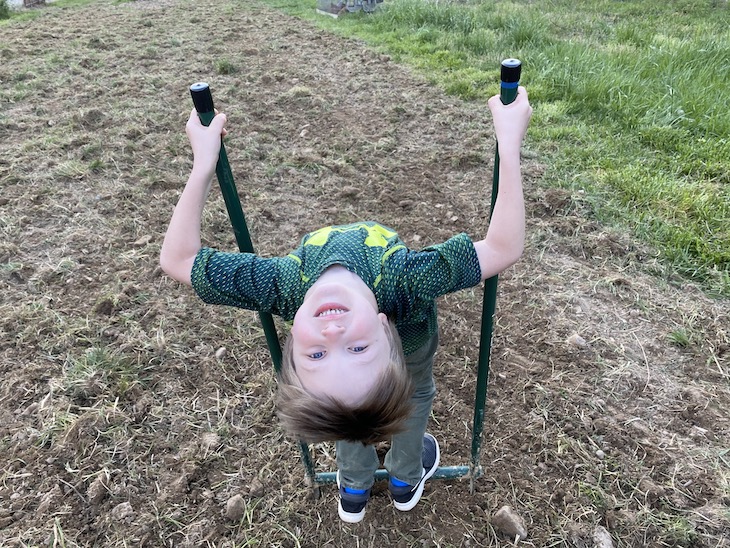
You then bring the fork back about a foot and do it all again. You actually work backward through this process. Break ground, drag the fork back, push it in, break ground, repeat. If you’re one of those aforementioned no-till gardeners, you can use a broadfork to gently loosen up the ground, just pulling it back a bit and then withdrawing it.
When you watch videos about broadforking, you almost always see the demonstrator jam in the fork and pull back loose, fluffy soil. Lies! OK, maybe not lies, but a lot of times these guys are broadforking soil that’s already well worked. if your soil is hard and compacted like mine, you’re going to pull up big plugs of hard ground. David the Good shows a more realistic demonstration.
My ground is so treacherous that I usually don’t stand on the broadfork. I put the fork on the ground, put my foot on the bar and push it in, rocking the fork to work around rocks as the tines sink in. I then pull back only about six inches before doing it again in order to break up more ground.
Let’s talk about the Meadow Creature broadfork and why it’s the best in its class.
The People’s Broadfork
If you’re like me, you read a review wondering what the price is until the very end. I’ll get that out of the way now: it’s $214 direct from Meadow Creature, not counting shipping, which brought the total to about $250 for me.
I know what you’re thinking. As Chris Rock’s Cheap Pete character would say, “Good lord, that’s a lot of money!” You could buy a tiller for that price, but I think the Meadow Creature broadfork is well worth it.
The Meadow Creature broadfork is entirely welded (with nice, fat beads). Many broadforks feature bolt-on handles, made of either wood or fiberglass. Those have some advantages, such as being lighter and letting you swap out the handles, but those will eventually break, especially if you’re dealing with my soil. The Meadow Creature is a buy-once-cry-once affair.
The other impressive thing about the Meadow Creature is the tines. Many broadforks have tines that are thin, nail-like spikes. Not the Meadow Creature. They’re not really tines, but giant claws. Think Wolverine claws, except sized for the Hulk. The Meadow Creature tines aren’t thin little wisps that will bend every which way when they hit a rock, they’re more like something you’d see hooked up to a tractor. The tines do bend just a little to the sides to accommodate rocks and other obstacles, but they won’t get bent out of shape. David the Good has used his to pry whole boulders from his gardens without damaging the fork.
The Meadow Creature broadfork won’t break on you. As someone who’s broken several garden tools, including a tractor, that’s important. And when the proverbial stuff has hit the fan, you don’t want to be dealing with equipment repairs.
Sure, you could buy a tiller for that price, but not a very good one. The tiller will need gas, oil, and all the other usual maintenance headaches that two-cycle engines demand. And tillers only work about the top six inches of soil, while the People’s Broadfork reaches down an entire foot. There are longer models with 14- or 16-inch tines, but I think they’re overkill for most people.
As an alternative, you can make your own broadfork, assuming you have a welder and tools, and the skill to use them. You can make one pretty cheaply if you can source the scrap metal.
Digging a Bed
If you’re preparing a new garden bed, how do you go from breaking ground with the broadfork to a finished bed ready for planting? I spent several months struggling to do this with a hodgepodge of tools, but the trick turned out to be a pointed hoe, which can easily chop through soil and leftover roots, as well as move dirt to perform rough bed shaping.
Here’s how I’ve been digging beds this fall:
- Measure out and mark a reasonably sized bed. I like 4×8 because it’s large but not overwhelming, and I can easily reach the center of the bed from either side.
- Use a scythe and a string trimmer to remove as much foliage as possible.
- Take the broadfork and break up the measured plot.
- Use the pointed hoe to chop up the broken ground, dragging the soil from the edges to the middle. This is usually when I add compost to add fertility and tilth to the soil.
- Finally, use a hard-tined bow rake to shape the bed and remove large clods to create a fine seedbed.
I consider the broadfork and pointed hoe an essential combo for hand-digging garden beds. Trying to do this stuff with regular shovels, mattocks, and garden hoes is a frustrating, back-breaking task.
What’s great about the broadfork is you can use it in all sorts of different ways. If you wanted to do a proper double-dig, you could first break the ground with the broadfork, which makes jamming in a shovel a lot easier. And as I mentioned above, you can use a gentler touch to loosen soil for lasagna gardens and compost piles. The possibilities are endless.
